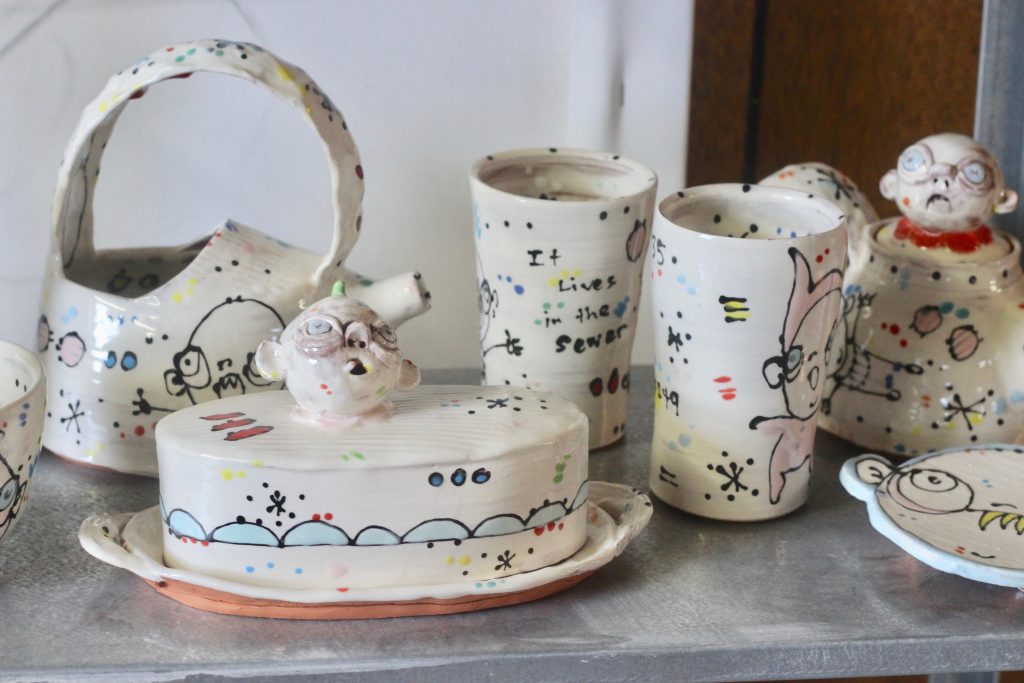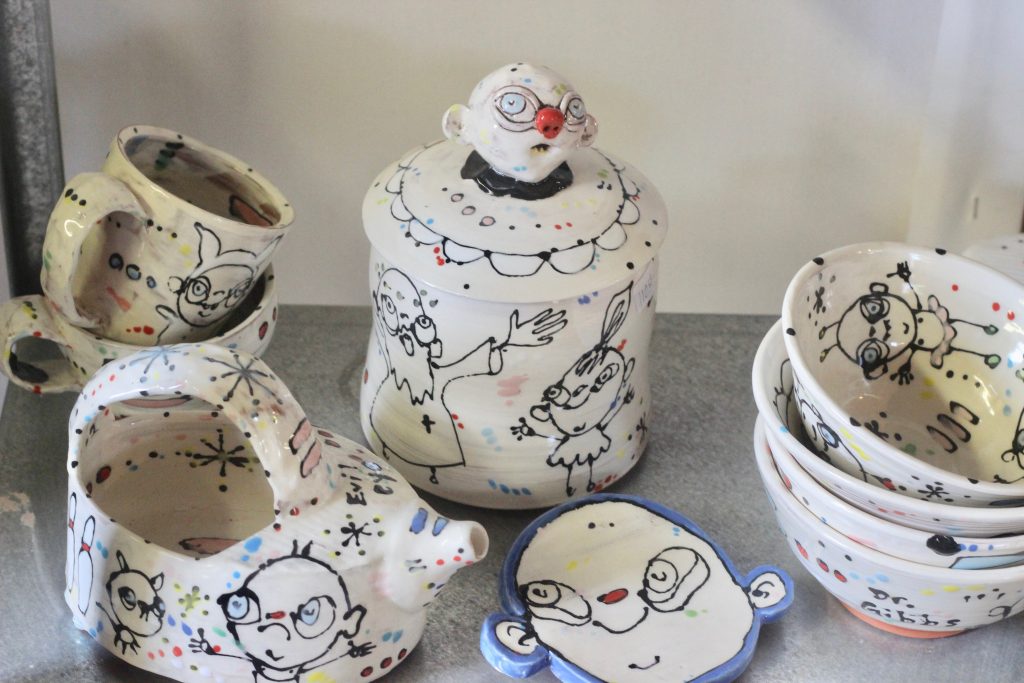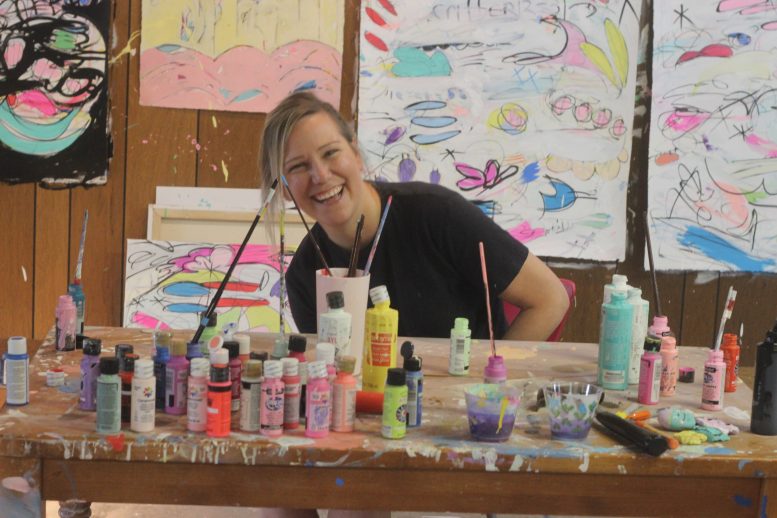By DAVID DUPONT
BG Independent News
When Carrie Day was a child her parents told her that she looked like the demonic baby from the horror movie “It’s Alive.”
It was a little messed up, she says, now. That baby, who came to be known as Critter, stares out from the walls and shelves of Day’s studio in Bowling Green. Artfully scrawled in a deceptively childlike hand, the figure is at once grotesque and adorable, a contemporary vision of a gargoyle. An imaginative figure rooted in a complicated reality.
Pottery lovers around the country welcome Critter into their collections. Friends from Day’s hometown Fostoria still call her Critter.“
They remember the sayings that Day inscribes in her work.
The form bursts from cups, butter dishes, gravy boats, and bowls, and it’s buried in the abstract layers of the paintings that hang on the wall, their colors complementing the vivid hues of the pots.

“They’re all about my childhood and childhood memories,” Day said. “That’s why I draw in that style. I can draw people realistic, but it fits the style. It fits the clay. People respond to it.”
Day’s work has attracted attention and buyers nationally through galleries in Chicago and Iowa City.
The childhood that Day draws on was marked by family dysfunction and struggles with serious mental health issues. “It’s uncomfortable to talk about but I realize it’s all part of the work. I want to talk about it through the art.”
When she was 11 her parents divorced. She and her two older sisters lived with their father who would take off for weeks at a time leaving them at home. “I was very independent from a young age.”
Through all this, Day made art.
“It’s weird. It sounds cheesy,” she said. “It’s not even that I wanted to be an artist; I knew that’s what I was.”
She won “little” prizes. One was a young illustrator award that earned her a trip to the Mazza Gallery in Findlay to see a presentation by Marc Brown, the author and illustrator of the Arthur children’s books.
His demonstration made an impression on her. “I think about this as I paint,” Day said. “He drew on paper, all these scribbles and marks, and then he found pictures in it.” That’s where he found his characters, Brown said.
Still when she was in high school she was uncertain about her future direction. Her art teacher asked her about her college plans, she wasn’t sure she was going after all few people she knew went to college and no one in her immediate family had graduated from college. And she didn’t know what she wanted to study. “He looked at me like I was insane,” Day said. For her teacher it was obvious — she should study art. Day didn’t even realize that was a possibility.
She ended up attending Bowling Green State University as an art major starting in 1998. Up until that time she created mostly realistic drawings and paintings. She had to take a ceramics course as a requirement. She found this very frustrating because she struggled to learn how to operate the wheel. “I got really obsessed with wanting to get good with it. I’d be there all night,” Day remembers. “I kept practicing, and I fell in love with it.”
Day was in her third year at BGSU when another student noticed the doodles on her notepad during a ceramics glazing class. The student suggested Day add those figures to her pots. “I’d never thought of that so I started, and it felt really natural. So I kept going with it.”

She left BGSU about a year shy of graduation to get married. She gave birth to two daughters. Through this time she continued to paint, even if it was on cardboard after the girls were in bed. She didn’t have access to equipment for ceramics though. Then she found a shop in Findlay. Its customers mostly painted figurines, but the shop was equipped with a wheel as well as a kiln. The owner said she could use the equipment if she taught classes.
In 2009, after she was divorced, she returned to BGSU, taking two years to earned her degree.
Day alternates between focusing on ceramics and painting.
The pandemic has cast a pall over the art scene with most shows canceled. One was the planned opening of the new gallery space adjacent to BG Beer Works. Justin Marx, who owns the microbrewery, asked her to display her art in the inaugural exhibit in late July. Now that’s been postponed, which Day feels is for the best. She had reservations about asking people to gathered in the space.
She has participated in virtual shows including a fundraiser for the NAACP Legal Defense Fund that raised $12,000.
With demand for pottery low, Day concentrates on painting.
She starts with an underdrawing. She’ll paint over some her initial work. The painting progresses through this push and pull. Some images pushed into the background, others pulled forward.
As she pulls images from her psyche, she shapes them with a eye toward design.
“I like the rawness of the expression, but I also like the sophistication of editing things out,” Day said. “You don’t need every mark in a painting to make it strong, you just need the really good ones.”
She likes the painting as much as the pottery, though she finds it harder to find time for it.
If she has a pottery show coming up, she has to build up her inventory.
If the gallery needs 20 pieces, she sets out to do 30 and ends up firing 100.
She adjusts what she makes to the demand. Some buyers only collect cups, others butter dishes. She did a group show featuring gravy boats. “I didn’t even really know what my idea of what a gravy boat is. …. I had to mess around. … They all sold.”
Her labors continue even as she struggles with rheumatoid arthritis, which developed when she was 27 after the birth of her second child.
“It’s hard to work with my hands, but I do it anyway,” Day said. She has flare ups. For a time she could not execute the motions needed to shape a vase. She thought she’d never make one again. Now she can again. Still this has her rethinking the value of her work. Before she may have priced items low believing she’s could always make 10 more. Now she faces the finite limits of what she can do.
What’s hard for the artist to face is the possibility she’ll have to stop making pottery altogether. “It makes me sad to think about not doing ceramics.”
So she persists in the work, despite the pain, continuing to share the visions of Critter with the world.

